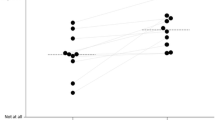Abstract
This study explored the effect of music and imagery on plasma β-endorphin in 78 undergraduates. Subjects screened for relevant psychological and health criteria were assigned to music imaging, silent imaging, music listening, and control conditions. Subjects donated 15 ml of blood prior to and following the 2-hr intervention period. There were no group differences in potential confounding variables. Split-plot factorial analysis controlling for individual differences in pretest level of β-endorphin revealed that those in the music imaging group experienced a significant pre–post decline in β-endorphin, while no other group demonstrated any significant pre–post difference. These data suggest that music imaging may lower peripheral β-endorphin levels in healthy subjects. Further exploration of the effects of music and imagery interventions on physiology and health may be warranted.
Similar content being viewed by others
REFERENCES
Allen, M. E., and Coen, D. (1987). Naloxone blocking of running-induced mood changes. Ann. Sports Med. 3: 190–195.
Banks, W. A., and Kastin, A. J. (1990). Peptide transport systems for opiates across the blood-brain barrier. Am. J. Physiol 259: E1–E10.
Bartlett, D., Kaufman, D., and Smeltekop, R. (1993). The effects of music listening and perceived sensory experiences on the immune system as measured by interleukin-1 and cortisoi. J. Music Ther. 30: 194–209.
Blake, R. L., and Bishop, S. R. (1995). The Bonny method of guided imagery and music (GIM) in the treatment of posttraumatic stress disorder (PTSD) with adults in a psychiatric setting. Music Ther. Perspect. 12: 125–129.
Bonny, H. (1978a). Facilitating Guided Imagery and Music Session, Bonny Foundation, Salina, KS.
Bonny, H. (1978b). The Role of Taped Music Programs in the GIM Process, Bonny Foundation, Salina, KS.
Clark, M. F. (1991). Emergence of the adult self in guided imagery and music (GIM) therapy. In Bruscia, K. E. (ed.), Case Studies in Music Therapy, Barcelona, Phoenixville, PA, pp. 321–332.
Clark, W. C., Yang, J. C., and Janal, M. N. (1986). Altered pain and visual sensitivity in humans: The effects of acute and chronic stress. Ann. N.Y. Acad. Sci. 30: 116–129.
Crowne, D. P., and Marlowe, D. (1964). The Approval Motive: Studies in Evaluative Dependence, Wiley, New York.
Fischer, E. G., and Falke, N. E. (1984). Beta-endorphin modulates immune functions: A review. Psychother. Psychosom. 42: 195–204.
Gilman, S. C., Schwartz, J. M., Milner, R. J., Bloom, F. E., and Feldman, J. D. (1982). Beta-endorphin enhances lymphocyte proliferation responses. Proc. Natl. Acad. Sci. U.S.A. 79: 4226–4230.
Goldberg, F. S. (1995). The Bonny method of guided imagery and music. In Wigram, T., Saperston, B., and West, R. (eds.), The Art and Science of Music Therapy: A Handbook, Harwood Academic, Australia, pp. 112–124.
Goldstein, A. (1980). Thrills in response to music and other stimuli. Physiol. Psychol. 8: 126–129.
Hall, H. (1984). Imagery and cancer. In Sheikh, A. A. (ed.), Imagination and Healing, Baywood, New York, pp. 159–169.
Heijnen, C. J., Kavelaars, A., and Ballieux, R. E. (1991). Corticotropin-releasing hormone and proopiomelanocortin-derived peptides in the modulation of immune function. In Ader, R., Felton, D. L., and Cohen, N. (eds.), Psychoneuroimmunology, 2nd ed., Academic Press, New York, pp. 429–444.
Jacobi, E. M. (1994). The Efficacy of the Bonny Method of Guided Imagery and Music as Experiential Therapy in the Primary Care of Persons with Rheumatoid Arthritis, Unpublished doctoral dissertation, Union Institute, Cincinnati, OH.
Jacobson, E. (1938). Progressive Relaxation, University of Chicago, Chicago.
Kalin, N. H., and Loevinger, b. L. (1983). The central and peripheral opioid peptides: Their relationships and functions. Psychiat. Clin. North Am. 6: 415–428.
Kanner, A. D., Coyne, J. C., Schaeffer, C., and Lazarus, R. S. (1981). Comparison of two modes of stress measurement: Daily hassles and uplifts versus major life events. J. Behav. Med. 4: 1–39.
Kusnecov, A. W., Husband, A. J., King, M. E., Pang, G., and Smith, R. (1987). In vivo effects of beta-endorphin on lymphocyte proliferation and interleukin 2 production. Brain Behav. Immun. 1: 88–97.
Luthe, W. (1969). Autogenic Therapy, Vol. 1, Grune and Stratton, New York.
McDonald, R. G. (1990). The Efficacy of Guided Imagery and Music as a Strategy of Self-Concept and Blood Pressure Change Among Adults with Essential Hypertension, Unpublished doctoral dissertation, Walden University, Minneapolis, MN.
McKinney, C. H. (1990). The effect of music on imagery. J. Music Ther. 27: 34–36.
McKinney, C. H., and Tims, F. C. (1995). Differential effects of selected classical music on the imagery of high versus low imageries: Two studies. J. Music Ther. 32: 22–45.
McKinney, C. H., Antoni, M. H., Kumar, A., and Kumar, M. (1995). The Bonny method of guided imagery and music (GIM), depression, and beta-endorphin in healthy adults: A pilot study. J. Assoc. Music Imagery 4: 67–78.
McKinney, C. H., Antoni, M. H., Kumar, M., Tims, F. C., and McCabe, P. M. (1996). Effects of guided imagery and music (GIM) therapy on mood and cortisol in healthy adults. Health Psychol. (in press).
Merritt, S. (1990). Mind, Musk, and Imagery: Unlocking Your Creative Potential, Penguin Books, New York.
Nichols Institute (1989). Allegro β-Endorphin: Human Beta Endorphin: Immunoassay for the Quantitative Determination of Human Beta Endorphin Levels in Serum or Plasma, Nichols Institute, San Juan Capistrano, CA.
Pickar, D., Cohen, M. R., Naber, D., and Cohen, R. M. (1982). Clinical studies of the endogenous opioid system. Biol. Psychiat. 17: 1243–1276.
Quittner, A. L. (1980). The Facilitative Effects of Music on Visual Imagery: A Multiple Measures Approach, Unpublished master's thesis, Florida State University, Tallahassee.
Satoh, Y., Nagao, H., Ishihara, H., Oyama, T., and Spintge, R. (1983). Effects of music on plasma stress hormones in surgical patients. Masui 32: 1211 (English abstract).
Sforzo, G. A. (1988). Opioids and exercise: An update. Sports Med. 7: 109–124.
Spingte, R, and Droh, R. (1987). Effects of anxiolytic music on plasma levels of stress hormones in different medical specialties. In Pratt, R. R. (ed.), The Fourth International Symposium on Music: Rehabilitation and Human Wett-Being, University Press of America, Lanham, MD, pp. 88–101.
Weiss, J. G. (1994). Accessing the inner family through guided imagery and music. J. Assoc. Music Imagery 3: 49–58.
Wildmann, J., Kruger, A., Schmole, M., Niemann, J., and Matthaei, H. (1986). Increase of circulatory beta-endorphin-Iike immunoreactivity correlates with the change in feeling of pleasantness after running. Life Sci. 38: 997–1003.
Wilson, S. C., and Barber, T. X. (1978). The creative imagination scale as a measure of hypnotic responsiveness: Applications to experimental and clinical hypnosis. Am. J. Clin. Hypnosis 20: 235–248.
Wrangsjo, B., and Korlin, D. (1995). Guided imagery and music as a psychotherapeutic method in psychiatry. J. Assoc. Music Imagery 4: 79–92.
Author information
Authors and Affiliations
Rights and permissions
About this article
Cite this article
McKinney, C.H., Tims, F.C., Kumar, A.M. et al. The Effect of Selected Classical Music and Spontaneous Imagery on Plasma β-Endorphin. J Behav Med 20, 85–99 (1997). https://doi.org/10.1023/A:1025543330939
Issue Date:
DOI: https://doi.org/10.1023/A:1025543330939




